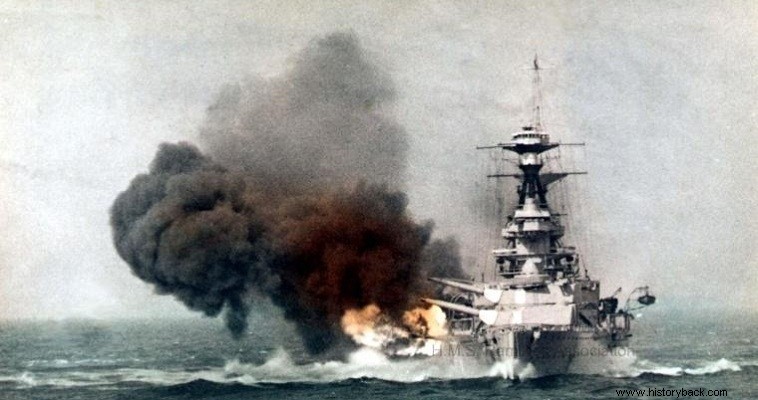
The Revenge class, also known as the Royal Sovereign class or the R class, was about 8 "super-dreadnought" battleships to complement the five ships of the Queen Elizabeth class. Of the 8 planned, only 5 were finally built due to the end of the First World War. Construction began in 1913 and the last was completed in 1917. They were HMS Revenge, HMS Resolution, HMS Royal Oak, HMS Royal Sovereign and HMS Ramillies. All names started with the letter R for it and the class was called the R class.
World War I
Revenge and Royal Oak managed to take part in the famousBattle of Jutland (31 May – 1 June 1916). At Jutland Revenge severely damaged the German battlecruisers Derfflinger and Von der Tann, while Royal Oak struck and nearly sank the German battlecruiser Seydlitz. A little later, after the naval battle, the Royal Sovereign joined service. All three witnessed the near engagement with the German fleet on August 19, 1916.
In early 1917 the Resolution also entered service. The boats proved to be very stable fire platforms. The external baffles for protection against torpedo hits that they had also contributed to their stability. The last, Ramillies, entered service in September 1917. The other three planned vessels (Resistance, Renown and Repulse) were cancelled. The names of the latter two were given to the two homonymous battlecruisers. After World War I the ships served in the Atlantic, the Mediterranean, the Aegean and the Black Sea. They underwent a limited modernization in the interwar period and were equipped with anti-aircraft guns.
World War II
With the outbreak of World War II, Revenge and Resolution joined the Channel Surveillance Force, while Royal Sovereign served in the Metropolitan Fleet . Ramillies was in Alexandria, Egypt with the Mediterranean Fleet and was immediately sent in pursuit of the German pocket battleship Graf Spee in Indian. Resolution and Revenge undertook a similar mission in the South Atlantic, accompanying convoys from Canada.
Royal Oak remaining at Scapa Flow main base torpedoed and sunk by German submarine U-47 which penetrated into the port. I took the ship to its wet grave with 833 men of its crew. Meanwhile the Ramillies were also used to transport troops from Australia to the Middle East. Resolution was the first to have the opportunity to use the guns participating in the naval campaign in Norway and the naval battle of Narvik . In May 1940 it was hit by German aircraft, but its strong armor protected it. At the same time Ramillies joined the Mediterranean Fleet in anticipation of Italy's imminent entry into the war.
Resolution joined Force H and took part in the operation against the French fleet at Oran (Mers-el-Kebir) while the Ramillies bombarded Italian positions in Libya, after the pompous Mussolini declared war on the Allies. In the meantime the Resolution was torpedoed by a French submarine of the Vichy navy. In response the Revenge bombarded the French port of Cherbourg destroying German war material being stockpiled there in anticipation of the planned invasion of Britain.
In the meantime the ships were provided with additional anti-aircraft guns, as well as additional armor in the ammunition stores of three of them (Resolution, Royal Sovereign and Ramillies), while some of the secondary 152 mm guns were removed. At the same time, new quarters were created for the additional personnel of the anti-aircraft guns.
In late 1940 the Revenge, Royal Sovereign and Ramillies returned to the Atlantic to deal with the German Scharnhorst and Gneisenau . Revenge and Ramillies joined the pursuit of Bismarck . Resolution remained under repair until 1941. After the repairs were completed she was sent along with her three sister ships to the Indian Ocean. The four Rs formed the 3rd Battleship Squadron tasked with countering the Japanese threat. They took part in operations in the Indian Ocean while the Ramillies took part in the Battle of Madagascar where it was torpedoed by a Japanese submarine.
In late 1943 the battered Revenge and Resolution returned to Britain. The first carried British Prime Minister Churchill on his sea route to the Tehran Conference with Roosevelt and Stalin. But then the Resolution became a training vessel while the Revenge was decommissioned. In January 1944 the other two vessels of the class returned to Britain.
Ramillies took part in supporting the forces that landed in Normandy on 6 June 1944,while Royal Sovereign was loaned to the Soviet Navy as Arkhangelsk. The great ships Revenge, Resolution and Ramillies were finally driven, ingloriously, to the scrap yard in 1948. The Royal Sovereign was only returned by the Soviets in 1949 and in poor condition. That's how it ended up in the scrapyard in 1949.
Technical characteristics during their construction
Displacement complete: 33,350 tons
Length: 189.2 m.
Width: 27 m.
Draft: 10.2 m.
Propulsion: 2 Parsons steam turbines, 18 Babcock &Wilcox boilers, power 40,000 HP
Maximum speed: 24 knots
Energy radius: 13,000 km at a speed of 10 knots
Crew: 940 men
Armament: 8 15in (381mm) guns in 4 twin turrets (879kg projectile, maximum range 30,640m), 14 6in (152mm) guns in equal number of simple guns (45kg projectile, maximum range 12,400m ), six anti-aircraft guns, 4 21in ( 533 mm) torpedo tubes.
Armour: Battleship belt, maximum thickness 330 mm. armored deck, maximum thickness 102 mm. main tower bases, maximum thickness 254 mm. main gun turrets, maximum thickness 330 mm. Battle Steering Center 279mm destroyer bulkheads 152 mm.
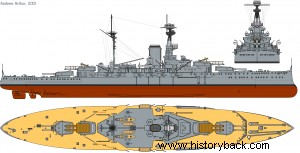
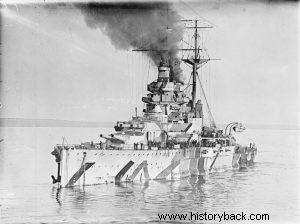
The HMS Ramillies.
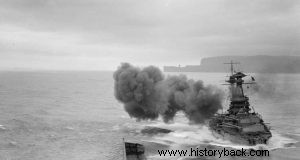
HMS RoyaL Oak fires.
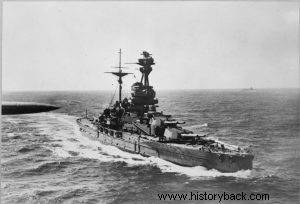
The HMS Revenge.
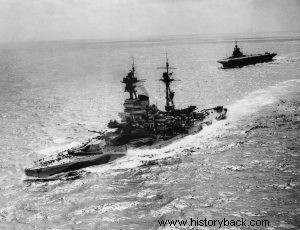
The HMS Resolution.
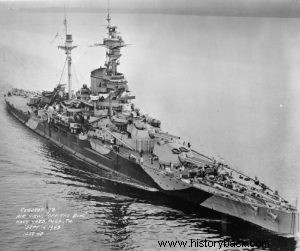
The HMS Royal Sovereign.
